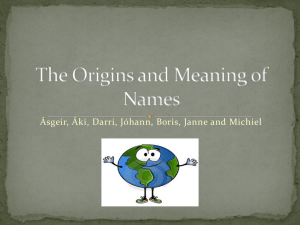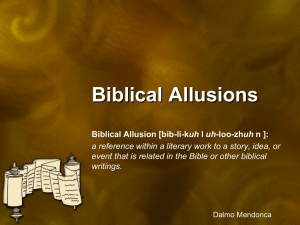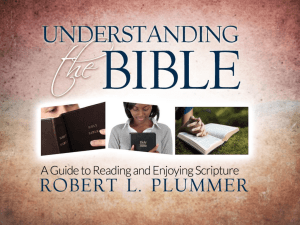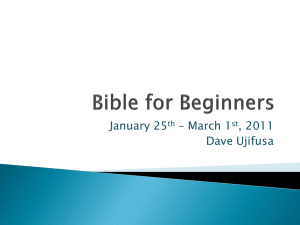EB 523 Hermeneutics
advertisement
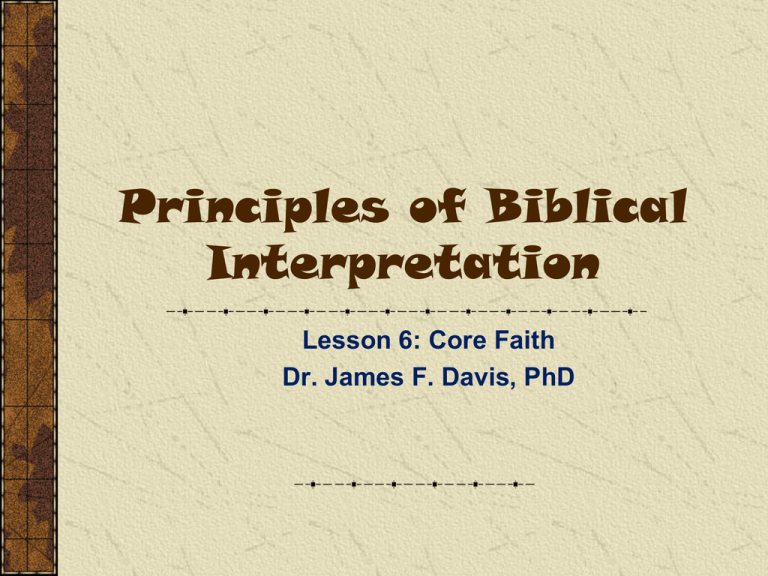
Principles of Biblical Interpretation Lesson 6: Core Faith Dr. James F. Davis, PhD Copyright Notice You may download this presentation on your computer for personal study or you can print it or use it in a multimedia presentation for yourself and others as long as you give the printed material away and do not charge for it. In this case, free means free. It cannot be bundled with anything sold, nor can you charge for shipping, handling, or anything. It cannot be posted on other websites or servers. It is provided for personal study or for use in preparation and presentation of sermons, Sunday school classes, undergraduate or seminary religion classes or other non-commercial study. Material in the presentation may be edited (added to , deleted or changed) on the condition that no revision contradicts the Bible.org doctrinal statement and that substantive revisions are identified as being the work of a reviser and not that of Dr. Davis. The Biblical Studies Foundation Things We Sometimes Hear Well, that’s just your interpretation. The Bible can be made to say anything you want. You can’t really understand the Bible. It is full of contradictions. No one can understand the true meaning of anything anyone says.” This is what the Bible means to me. All of these are about principles of biblical interpretation also called in theological jargon hermeneutics The Biblical Studies Foundation Welcome to Our Post-Modern World Pilate’s Question Lives ON!! “What is truth?” The Biblical Studies Foundation Overview of Lesson How does divine inspiration and human authorship affect biblical interpretation? What does a text mean? What are some general principles of interpretation? How do I interpret the Old Testament? How do I interpret the New Testament? The Biblical Studies Foundation What Does a Text Mean? In the last lesson we looked at the topic of inspiration and found that the Bible is both a human book and a divine book. Implications for Bible Interpretation Human authors had a specific historical audience, context and purpose Human authors used their own language, writing methods, style of writing and literary form of writing The Divine authorship of the Bible gives it its unity and the ultimate interpretation is from God. The Biblical Studies Foundation Question: What does a text mean? The Biblical Studies Foundation Answer : A text means what the author intended it to mean! The Biblical Studies Foundation Personal Letter Illustration If you wrote a letter what does it mean? What your interpretation is or how the recipients interpret it? The Biblical Studies Foundation General Principles Biblical interpretation: Principle 1: Authorial Intent: Interpretation must be based on the author’s intention of meaning and not the reader. This means we must get into the author’s context Historically, Grammatically, Culturally And the Literary forms and conventions the author was working in. The Biblical Studies Foundation General Principles Biblical interpretation: Principle 2: Interpretations must be done in the context of the passage (sentence, paragraph, section, book). What does the following mean? It was a ball? • The baseball umpire saw the pitch drift to the outside and said, “it was a ball.” • We went to the dance last night in fact it was so formal “it was a ball.” • As I was walking along the golf course I spotted something small and white in the tall grass, “it was a ball.” • I had so much fun at the game night. “It was a ball.” The Biblical Studies Foundation CONTEXT DETERMINES MEANING!!! The Biblical Studies Foundation Context of 1st century Author then Bible Book Larger section Paragraph Immediate Context Verse Circles of Literary Context General Principles Biblical Interpretation: Principle 3: Interpret the Bible literally allowing for use of normal figurative language. When the literal does not make sense (e.g., trees clapping their hands) you may have a figure of speech. The Biblical Studies Foundation General Principles Biblical Interpretation: Principle 4: Use the Bible to help interpret itself. Interpret difficult passages with clear ones. This is sometimes also called the law of noncontradiction. • For example there are clear passages in my view that teach eternal security (John 5; Rom 8) so I would let this influence me that a very hard passage like Heb 6 is not teaching that one can lose his salvation. Use the New Testament to help interpret the Old Testament. This recognizes this progressive nature of revelation but also one must start by interpreting the OT in its context before a NT consideration is made. The Biblical Studies Foundation General Principles Biblical Interpretation: Principle 5: Interpretation must be distinguished from application. While there is one interpretation that is historical there are many applications that can be carried over to our modern context. Build the application bridge Interpretation Then Application Now The Biblical Studies Foundation General Principles Biblical Interpretation: Principle 6: Be sensitive to distinctions between the Israel and the church and Old Covenant and New Covenant eras/requirements Promises made to Israel (like the land promises) cannot automatically be transferred to the church. Christians are not under the requirements of the Mosaic law (Rom 6:14). The church was formed in Acts 2 with the descent of the Holy Spirit and most direct statement to and about the church occur after that. There is a future for national Israel (cf Rom 11). The Biblical Studies Foundation General Principles Biblical Interpretation: Principle 7: Be sensitive to the type of literature you are in. For example law, narrative, wisdom, poetry, gospel, parable, epistle, apocalyptic. Each of these types of literature have specific features that must be considered The Biblical Studies Foundation Interpreting the Old Testament Narrative: Interpret the passage in its historical context then look for lessons and applications from the characters and events. Why do you think God included this passage? Only one verse is given to the judge Shamgar. After Ehud came Shamgar son of Anath; he killed six hundred Philistines with an oxgoad and he too delivered Israel (Judges 3:31). The verse teaches God’s delivering power can come in an unexpected way (Not with an army but with one man with an oxgoad). The Biblical Studies Foundation Interpreting the Old Testament Law: Realize that Christians are not under the law as a legal system (Rom 6:14) but that we are to fulfill the principles that stand behind the law of loving God and loving one’s neighbor (Cf Matt 22:37-40)? Look for the principle. Sometimes the teaching is carried directly into the New Testament (e.g., Do not murder etc). You must not muzzle your ox when it is treading grain (Deut 25:4) Paul takes this verse and applies the principle of the “worker” being worthy of tangible support: Elders who provide effective leadership must be counted worthy of double honor, especially those who work hard in speaking and teaching. 5:18 For the scripture says, “Do not muzzle an ox while it is treading out the grain,” and, “The worker deserves his pay.” (1 Tim 5:17-18, cf. 1 Cor 9:9) The Biblical Studies Foundation Interpreting the Old Testament Wisdom: Realize that much of the proverbial type of wisdom are general truths based on observations but not absolute truths or promises. A gentle response turns away anger, but a harsh word stirs up wrath (Prov 15:1). Train a child in the way that he should go, and when he is old he will not turn from it (Prov 22:6). The Biblical Studies Foundation Interpreting the Old Testament Poetry: Realize that poetry often has figurate language and Hebrew poetry’s main characteristic is parallelism. The Lord owns the earth and all it contains, the world and all who live in it. For he set its foundation upon the seas, and established it upon the ocean currents. Who is allowed to ascend the mountain of the Lord? Who may go up to his holy dwelling place? (Ps 24:1-3) The Biblical Studies Foundation Interpreting the New Testament Gospels: Understand that Each writer has a specific audience for whom he is writing and selects his material for them • Matthew was written for a Jewish audience • Mark was written for a Roman audience • Luke was written for a Greek audience • John was written for a universal or Gentile audience Read gospels not only vertically (what is said in each individually) but also horizontally (why one story follows another) (See Mark 2-3:6; What do these accounts have in common?) . Recognize that the gospels are in a transitional stage between Old and New Covenants (e.g., Mark 7 where Jesus declared all foods clean) The Biblical Studies Foundation Interpreting the New Testament Parables (Adapted from Roy Zuck, Basic Bible Interpretation): Determine the context that prompted the parable Understand the story’s natural meaning Ascertain the main point or truth the parable is trying to give Only interpret the details of the parables if they can be validated from the passage. Many details are there for the setting of the story only. E.g., What is the main point of the mustard seed parable? • He gave them another parable: “The kingdom of heaven is like a mustard seed that a man took and sowed in his field. 13:32 It is the smallest of all the seeds, but when it has grown it is the greatest garden plant and becomes a tree, so that the wild birds come and nest in its branches” (Matt 13:31-32) . The Biblical Studies Foundation Interpreting the New Testament Acts: Recognize that Acts is a theologized history of the early church. It tells what the church is doing and what God is doing. • So those who accepted his message were baptized, and that day about three thousand people were added. . . . (Acts 2:41) • And the Lord was adding to their number every day those who were being saved (Acts 2:47) Church starts in Acts 2 with the Baptism of the Holy Spirit. Some events are descriptive of what happened not proscriptive of what we see in the church today. • Samaritan Believers not having the Holy Spirit in Acts 8 upon faith in Jesus (Waiting for Peter and John to get there). • Paul bitten by a viper in yet miraculously living (Acts 28:1-5) The Biblical Studies Foundation Key Transitions in the Book of Acts Biography(Especially from Peter to Paul) Paul Paul/Barnabas Barnabas/Saul Philip Stephen Peter/John Jesus The Biblical Studies Foundation Key Transitions in the Book of Acts Ministry Focus Gentiles Samaritans Jews The Biblical Studies Foundation Key Transitions in the Book of Acts Geography (Acts 1:8) Rome Europe Asia Minor Samaria Judea Jerusalem The Biblical Studies Foundation Interpreting the New Testament Epistles: Since the Epistles are directed to churches and individuals in the church they most directly apply to us. Pay special attention to logical connectors/conjunctions to explore. • Look for these words: “for, “therefore”, “but” etc. • So since we are receiving an unshakable kingdom, let us give thanks, and through this let us offer worship pleasing to God in devotion and awe. For our God is indeed a devouring fire (Heb 12:28-29). The Biblical Studies Foundation Interpreting the New Testament Revelation: Recognize that there are many Old Testament allusions in Revelation Recognize that there is a greater use of symbolic language than in other parts of the Bible Interpret the seven churches as seven historical churches from John’s day and from chapter 4 onward as primarily future events from our perspective (Rev 1:18-19). Follow a generally chronological view of the book sequencing the bowls, trumpets and seals, second coming of Jesus, millennial kingdom and eternal state. The Biblical Studies Foundation Discussion Questions What types of interpretations have you heard where you questioned the method of interpretation? What would happen to interpretation if the church to a reader centered interpretation as opposed to an author centered interpretation? How does the Holy Spirit help us in interpreting the Bible (1 Cor 2)? If the Holy Spirit is guiding us in interpretation why do godly Christians have differing interpretations on various passages? The Biblical Studies Foundation Discussion Questions What is our relationship, if any, to the Old Testament Commandments/Law? Why are only 9 of the 10 commandments repeated in the New Testament? The Sabbath command is the one commandment that is not there. How does the distinction between the church and Israel affect application of the Old Testament? How do you know if something is symbolic or not? The Biblical Studies Foundation
